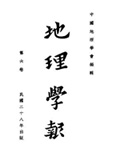Mei-Ngo Jen
Although records on the Yellow River are voluminous, they are often overburdened with great engineering details and scattered in a large number of technical journals and publications as to be not readily available to geographical students. "A Symposium on the Yellow River". appeared in 1935, is one of the most noteworthy contributions on the subject. It consists of 3 volumes, Vol. 1 by H. Y. I-Iu on climate, Vol. 2 by T. F. Hou on geology and Vol. 3 by H. Y. Chang on hydrology. At that time, attention was only paid to flood control with occasional considerations in irrigation and navigation. Moreover, hydrometric and gaging stations were few, especially on th0 upper reaches of the river, and the records then available often covered tco short a period to be valuable for sound generalizations. Many important items, such as soil and Soil erosion, were only incompletely known. Much valuable data have since been accu- mulcted. During the war years, the Japanese had made a comprehensive study covering the area from Paotou to the sea. Their plan for developing the Yellow River contains much excellent material. At present,there are hydrometric and paging data from 139 stations and precipitation record from 138statibns on the Yellow River and its tributaries. Although flood control remains the most important items in any project on the Yellow River, recent investigation by both Chinese and Japanese engineers reveals that there is a huge amount of water power capable of development.
